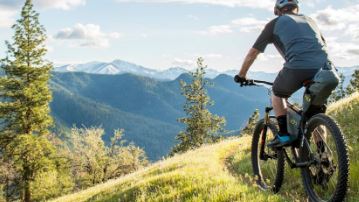Trail

Trail riders lean more towards the adventurous side of the sport. They may do some of the same things as cross country riders but look for bigger features and obstacles. A trail rider doesn‘t mind a long climb as long as the downhill gets the adrenaline pumping with jumps, drops, rock gardens and berms. Trail riders often ride a wide range of trail types but always keep an uphill speed. Getting to the top of the hill is merely payment for the fun of the down.
The characteristics of a trail bike are
- Full suspension
- Agressive slack geometry
- Nobby wide tires
- Hydraulic brakes
Front suspension
A trail fork will be heavier and burlier with fork stanchions (legs) between 34mm and 36mm to increase stiffness and steering precision when a rider is plowing through rough stuff at speed. A trail bike fork will be between 130mm and 170mm of travel in order to handle more technical terrain, bigger drops and jumping. A trail fork will generally have an air spring but there are some coil spring options available. (Coil sprung forks tend to be heavier.) A trail fork will have a fork lockout and may have travel adjustment to lower the front of the fork when climbing.
Rear suspension
Full suspension is the rule for trail bikes although some hardtails are available that are designed with slacker trail bike geometry and longer forks. With rear suspension that ranges from 120mm – 160mm of travel, trail bikes are designed to chew up rocky, technical terrain at speed, handle drops and catch air. Trail bikes often can be pointed straight through the rough stuff. Line choice isn‘t as crucial as it is with a cross country bike where a rider will have to be more selective with line choice. Shorter travel trail bikes lean more towards the XC category while long travel trail bikes lean more towards the enduro/downhill category. The longer travel bike can handle more aggressive, black diamond-like trails. Most trail bikes have a rear air shock with a lockout switch to firm up the ride during climbing and spinning along on flat terrain.




